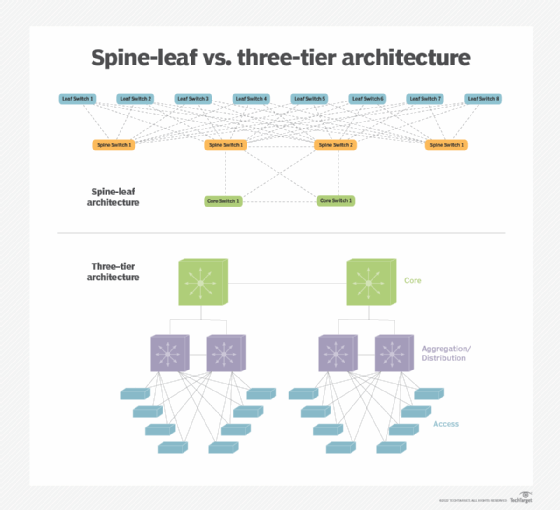Spine-leaf (spine-leaf architecture)
What is spine-leaf architecture?
Spine-leaf, or leaf-spine, is a two-layer network topology composed of spine and leaf switches. A spine-leaf architecture helps data center networks reduce network latency and hop count and improve network efficiency.
This two-layer full-mesh network topology was designed as an alternative to three-tier architectures and is suitable for modern data centers that experience more east-west network traffic than north-south or switch-to-switch traffic. East-west traffic flows transfer data packets from server to server within a data center. The two-tier topology is composed of the following:
- Spine switches. Leaf switches connect to spine switches and mesh into the spine, forming the access layer that delivers network connection points for servers.
- Leaf switches. Servers and storage connect to leaf switches and consist of access switches that aggregate traffic from servers. They connect directly to the spine.
Every leaf switch in a spine-leaf architecture connects to every switch in the network fabric. No matter which leaf switch a server is connected to, it must cross the same number of devices every time it connects to another server. (The only exception is when the other server is on the same leaf.)
Spine-leaf minimizes latency and bottlenecks because each payload only has to travel to a spine switch and to another leaf switch to reach its endpoint. Spine switches have high port density and form the core of the architecture. Switches in a spine-leaf architecture can also help in scaling, as multiple switches can be used in a data center switching architecture.
How does a spine-leaf architecture differ from traditional three-tier architecture?
The biggest differences between spine-leaf and traditional architecture are the number of network layers and the traffic involved.

Traditional architectures typically have a three-tier network that handles north-south traffic. They consist of a core, the aggregation/distribution layer and access layer. The core layer interconnects data center aggregation modules while connecting to the core of a network. Access switches connect to servers and storage devices while the aggregation layer brings together access layer traffic and provides a redundant connection to the access layer. Three-tier architectures also use the Spanning Tree Protocol (STP).
Conversely, the spine-leaf architecture uses just the two spine and leaf layers to create a two-layer topology. Connections are made through the spine layer, enabling a single hop between leaves and minimizing latency and bottlenecks.
Spine-leaf is meant for east-west traffic and doesn't use the STP protocol. Although STP has redundant paths between switches, only one can be activated at a time, which means paths can become oversubscribed. Not using STP minimizes latency and potential bottlenecks for the spine-leaf architecture.
How to design spine-leaf architecture
When designing a spine-leaf architecture, an organization should consider oversubscription rates, spine and leaf sizing and what layer it's built on.
The oversubscription rate is when all devices are sending traffic at one time, and this traffic can't be aggregated on the active link. As a ratio, the oversubscription rate should be less than 3:1. The ratio should be measured using upstream bandwidth and downstream capacity.
Spine and leaf sizing is the maximum amount of leaf switches in the topology. The spine switches' port density determines the leaf switch sizing. Port density and leaf switch throughput determine spine switching size.
A spine-leaf topology can also be Layer 2 or Layer 3 of the Open Systems Interconnection (OSI) architecture model, depending on whether the links between the leaf and spine layer are switched or routed.
In a Layer 2 spine-leaf design, TRILL or SPB take the place of STP. All hosts are linked to the fabric and offer a loop-free route to their Ethernet Media Access Control (MAC) address through a shortest-path-first computation.
In a Layer 3 design, each link is routed. This approach is most efficient when virtual local area networks are sequestered to individual leaf switches or when a network overlay, such as VXLAN, is working.
Advantages of spine-leaf architecture
A spine-leaf architecture offers data centers the following benefits:
- Redundancy. Each leaf switch connects to every spine switch, which increases the amount of redundancy while also reducing potential bottlenecks.
- Performance. Protocols such as Shortest Path Bridging (SPB) and Transparent Interconnection of Lots of Links (TRILL) aid in avoiding traffic congestion.
- Scalability. Additional spine switches can be added to help avoid oversubscription and increase scalability.
- Lower latency. Spine-leaf architecture has only two hops between source and destination nodes, which means fewer aggregation switches and redundant paths between switches. This design helps reduce latency and power requirements.
- Reduces spending. A spine-leaf architecture increases the number of connections each switch can handle, so data centers require fewer devices to deploy.
Limitations of spine-leaf architecture
Although spine-leaf brings centralized network traffic processing, it still has many hardware requirements and traffic ratios. One of the larger drawbacks of the architecture is the required scale, which directly relates to the number of supported physical hosts. The more hosts supported, the larger the spine. In general, a spine can only extend so far before its switches run out of ports, it can't support interconnection between switches, or it reaches an oversubscription rate that's too high.
Spine-leaf architectures also have significant cabling requirements. The more spine switches, the more cables a setup requires. The number of necessary cables also depends on the number of spine switches -- the wider the spine, the more interconnect switches are needed.
Organizations should know the performance characteristics of spine and leaf switches, including their port density, virtualization abilities and redundancies, to properly fit their deployment needs.
Learn more about the spine-leaf network topology, which includes how it helps with network traffic.








